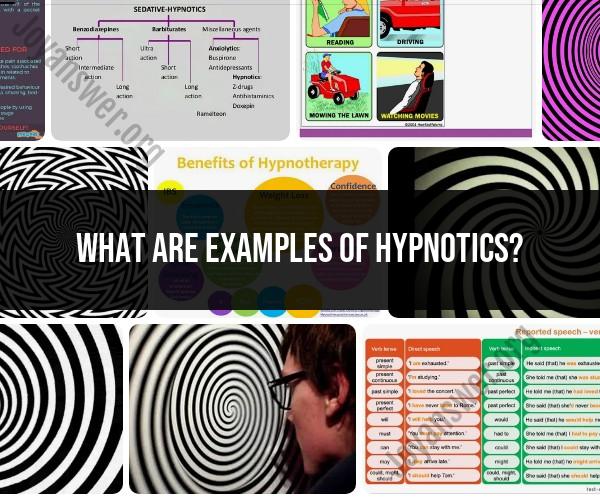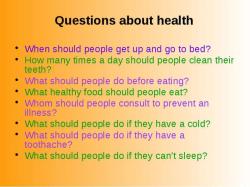What are examples of hypnotics?
Hypnotics are a class of drugs that are used to induce sleep or treat sleep disorders. They can help individuals fall asleep and stay asleep. These drugs work by depressing the central nervous system and slowing down brain activity. Hypnotics are generally divided into two categories: prescription and over-the-counter (OTC). Here are some examples of hypnotic medications:
Prescription Hypnotics:
Benzodiazepines: These drugs, such as temazepam (Restoril) or triazolam (Halcion), are central nervous system depressants that can help with short-term sleep problems.
Non-Benzodiazepine Hypnotics: These medications, like zolpidem (Ambien), eszopiclone (Lunesta), and zaleplon (Sonata), work similarly to benzodiazepines but are considered safer for long-term use.
Barbiturates: These are rarely used today due to their potential for dependence and overdose, but examples include pentobarbital and secobarbital.
Melatonin Receptor Agonists: Ramelteon (Rozerem) is a medication that works by affecting melatonin receptors in the brain, helping to regulate sleep-wake cycles.
Orexin Receptor Antagonists: Suvorexant (Belsomra) is a newer type of medication that works by blocking orexin receptors, which play a role in regulating wakefulness.
Sedating Antidepressants: Some antidepressant medications, such as trazodone and amitriptyline, are prescribed off-label for their sedating effects and are used to treat insomnia.
Over-the-Counter (OTC) Hypnotics:
Diphenhydramine: Found in products like Benadryl and some OTC sleep aids, diphenhydramine is an antihistamine that can cause drowsiness and is used as a short-term sleep aid.
Doxylamine: This antihistamine is found in some OTC sleep aids, such as Unisom, and can help with occasional sleeplessness.
Melatonin Supplements: In addition to prescription melatonin receptor agonists, melatonin supplements are available OTC and are used to help regulate sleep-wake cycles.
It's important to note that while hypnotic medications can be effective for treating sleep problems, they should be used under the guidance of a healthcare professional and only for the recommended duration. Prolonged or inappropriate use of these drugs can lead to tolerance, dependence, and side effects.
Additionally, non-pharmacological approaches, such as improving sleep hygiene, cognitive-behavioral therapy for insomnia (CBT-I), and lifestyle modifications, should be considered as part of a comprehensive approach to managing sleep disorders. If you're experiencing persistent sleep problems, it's advisable to consult with a healthcare provider to determine the most suitable treatment options.
Examples of Hypnotics: Medications for Sleep Disorders
Hypnotics are a class of medications used to induce sleep and treat insomnia. They are also sometimes used to treat other sleep disorders, such as restless legs syndrome and narcolepsy.
Some common hypnotics include:
- Benzodiazepines, such as alprazolam (Xanax), diazepam (Valium), and lorazepam (Ativan)
- Non-benzodiazepine hypnotics, such as zolpidem (Ambien), eszopiclone (Lunesta), and zaleplon (Sonata)
- Melatonin receptor agonists, such as ramelteon (Rozerem)
- Orexin receptor antagonists, such as suvorexant (Belsomra) and lemborexant (Dayvigo)
Common Hypnotic Drugs and Their Effects
Hypnotic drugs work in different ways to promote sleep. Benzodiazepines increase the activity of GABA, a neurotransmitter that has a calming effect on the brain. Non-benzodiazepine hypnotics work on similar targets in the brain, but they have a different chemical structure and may have fewer side effects than benzodiazepines.
Melatonin receptor agonists mimic the effects of melatonin, a hormone that regulates the sleep-wake cycle. Orexin receptor antagonists block the effects of orexin, a neurotransmitter that keeps us awake.
Prescribing and Using Hypnotics Safely
Hypnotics are prescription medications and should be used under the supervision of a doctor. Doctors will typically prescribe hypnotics for short-term use only, as they can be habit-forming and can lead to side effects such as dizziness, drowsiness, and memory impairment.
It is important to take hypnotics as prescribed and to avoid taking them with alcohol or other drugs. It is also important to avoid driving or operating machinery after taking hypnotics.
Alternatives to Medication for Sleep Improvement
There are a number of non-medication approaches to improving sleep, such as:
- Establishing a regular sleep schedule and sticking to it as much as possible, even on weekends
- Creating a relaxing bedtime routine
- Making sure your bedroom is dark, quiet, and cool
- Avoiding caffeine and alcohol before bed
- Getting regular exercise, but avoiding exercising too close to bedtime
If you have trouble sleeping, talk to your doctor. They can help you to identify the underlying cause of your insomnia and recommend the best treatment options for you.
Understanding the Role of Hypnotics in Healthcare
Hypnotics can be a valuable tool for treating insomnia and other sleep disorders. However, they should be used under the supervision of a doctor and only for short-term use.
There are a number of non-medication approaches to improving sleep that should be tried first. If these approaches are not effective, hypnotics may be considered.
It is important to weigh the risks and benefits of hypnotics before taking them. Hypnotics can be habit-forming and can lead to side effects such as dizziness, drowsiness, and memory impairment.
If you are prescribed hypnotics, be sure to take them as prescribed and to avoid taking them with alcohol or other drugs. It is also important to avoid driving or operating machinery after taking hypnotics.













